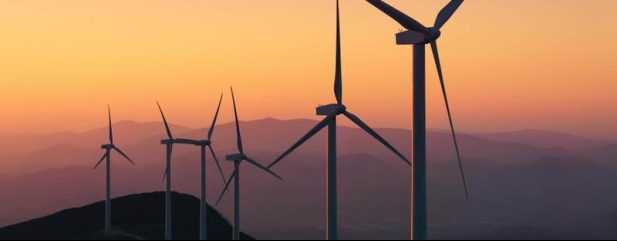Why have renewable energy funds performed so poorly?

Rewind to 2020, five years on from the landmark Paris Agreement to combat climate change, and aside from the pandemic the big stories in markets were the ‘climate emergency’ and the ‘energy transition’.
Although the Glasgow COP26 conference had to be postponed until 2021 due to Covid, there was no shortage of high-profile events from Manchester’s virtual four-day Green Summit to the WEF (World Economic Forum) Green Horizon Summit and the UN (United Nations) Climate Ambition Summit in London.
Speaker after speaker set out how their country was contributing to the global ‘pathway’ towards a greener planet, and it was a banner year for renewable stocks with the MSCI Global Alternative Energy index more than doubling.
Since then, the same index has lost roughly half its value and many funds and investment trusts have suffered even bigger drawdowns.
Shares went looking for answers as to why alternative energy and energy efficiency have been such poor investments.
WHY THE UNDERPERFORMANCE?
Alternative energy stocks have had a poor run over the last three years, particularly relative to the MSCI World index, only some of which can be put down to the extraordinary performance of the Magnificent Seven which now make up a significant part of the global benchmark.
By comparison, three quarters of the MSCI Alternative Energy index is made up of utility and industrial stocks, while it is overweight small-caps and heavily underweight the factors which have driven global markets to new highs, namely momentum, low volatility and quality (as measured by balance-sheet strength).
For renewable energy infrastructure and energy efficiency funds in general, another major headwind has been the sharp increase in interest rates over the past couple of years which has had the twin effect of raising the cost of capital while reducing the attractiveness of their yields.
This has led to an exodus of investors into fixed-income securities including, ironically, ‘green bonds’, which for many tick the ‘responsible’ box without the hassle of owning green assets.
Compounding matters, the rebound from the pandemic in 2021 followed by the invasion of Ukraine in February 2022 sent oil and gas prices soaring, meaning the world’s focus turned from the ‘energy transition’ to ‘energy security’ with countries scrambling to secure supplies of fossil fuels.
As a result, sustained high energy prices have gifted mainstream oil and gas companies bumper profits, and although their share prices have risen they still look cheap on conventional metrics such as free cash flow yield, price-to-earnings and dividend yield.
In contrast, many renewable energy companies have struggled to grow their earnings over the same period, assuming they were profitable to begin with.
Therefore, investors looking to diversify their portfolios don’t have to stray too far from the shore if they want to find ‘value’, and big oil and gas companies have another key advantage in terms of the liquidity of their shares.
CLIMATE CHANGE NO LONGER A HOT-BUTTON ISSUE
Considering the US goes to the polls this year, and the country faced at least 28 natural disasters each costing $1 billion or more in 2023, the hottest year in its history, you might think the environment would be high on the list of voters’ and candidates’ priorities.
Not a bit of it, sadly, even with over a million acres of the Texas Panhandle, home to 85% of the state’s cattle, and parts of Oklahoma currently being consumed by a fire so large it can be seen from space.
While the Biden administration has done a remarkable job of pushing environmental awareness to the forefront with $200 billion of projects under the 2022 IRA (Inflation Reduction Act), which is aimed at reducing carbon emissions and investing heavily in renewable power, few voters today would put climate change near the top of their list.
As one environmentalist wryly put it to Bloomberg, ‘The climate movement doesn’t have a persuasion problem as much as it has a turnout problem.’
In other words, while everyone knows there’s a need to limit our emissions and fight climate change, on the list of day-to-day needs it hardly ranks up there with food, heating or keeping a roof over our heads.
More concerning, there has been a fierce political backlash against ‘green’ and environmentally responsible strategies in the US led by the Republican party and traditional energy companies.
Bloomberg reports that, at the state level, there have been more than 160 proposals largely attributable to Republican lawmakers seeking to ban investors and companies from considering ESG factors when making financial decisions.
No doubt cognisant of the risk of politically-motivated attacks if they continue to take climate-related investment decisions, last month three of the largest US wealth managers – JPMorgan Asst Management, State Street Global Advisors and Pacific Investment Management – withdrew from CA100+, the world’s biggest investor coalition on climate change.
‘Each asset manager gave its own, delicately phrased account for its actions, but the subtext was plain,’ said Bloomberg. ‘The Republican and fossil-fuel industry war on environmental, social and governance investing strategy makes taking climate action harder for investors.’
WHAT HAS THIS MEANT FOR INVESTORS?
Taking the AIC’s (Association of Investment Companies) Renewable Energy Infrastructure sector, which is made up of more than 20 trusts with combined assets of over £20 billion sector, as our base, it is clear that not only have asset values suffered as a result of the tide turning against alternative energy but share prices have suffered even more.
The average discount to NAV (net asset value) on an unweighted basis across the 21 funds in our table is 32%, while adjusting for size of funds the discount is still somewhere in the high 20% range.
For the billion-pound-plus companies the future looks reasonably secure as they have access to funding, but for many smaller trusts the odds on them continuing in their current form appear slim.
In December, Triple Point Energy Transition (TENT) bit the bullet and proposed a managed wind-down to maximise shareholder value, with investors set to vote on selling off the assets ‘in an orderly manner’ at a general meeting on 22 March.
Last week, Harmony Energy Income Trust (HEIT) revealed it was considering how best to deliver value to shareholders over the short term, including selling some assets to ‘demonstrate to the market the true value of the portfolio and the continuing disconnect with the share price’.
While this is a nice idea, if commercial property companies are any guide even selling assets at a premium to their last published NAV does little to influence share prices in the short term.
However, as we have seen with other areas of the investment trust universe, including commercial property, mergers may be a way out for investors.
In February, Aquila European Renewables (AERI) – whose shares are down 22% over the last year – revealed it was in talks with ‘multiple interested parties’ over a merger and was beginning the due diligence process.
One of the interested parties is Octopus Renewables Infrastructure (ORIT), whose shares are down a slightly less painful 14% over the past year, although the trust cautioned talks were at an early stage.
Analysts at Stifel suggest that as well as Aquila’s underperformance the decision to seek a combination with a rival may have been driven by its forthcoming continuation vote.
Continuation votes are usually triggered if the average discount to NAV exceeds 10% in a financial year, and the team at Stifel have identified five renewable trusts which they believe are likely to have to hold a vote this year.
‘Most shareholders will not want to put the funds into wind-up in the months ahead, given pricing for portfolio disposals is unlikely to be optimal and many investors own the funds for long-term dividend income,' surmise the analysts.
‘However,’ they add, ‘given wide discounts, we do think a number of shareholders may suggest boards provide some sweeteners in order to gain their support in these votes. This may include fee reductions and proposals to return cash to investors, possibly when assets are realised from portfolios.’
Some key dates for investors in renewable energy trusts:
25 March - Octopus Renewables full-year results
April - Greencoat UK Wind continuation vote
May - US Solar continuation vote
June - Foresight Solar continuation vote
August - NextEnergy Solar continuation vote
September - JLEN continuation vote
Important information:
These articles are provided by Shares magazine which is published by AJ Bell Media, a part of AJ Bell. Shares is not written by AJ Bell.
Shares is provided for your general information and use and is not a personal recommendation to invest. It is not intended to be relied upon by you in making or not making any investment decisions. The investments referred to in these articles will not be suitable for all investors. If in doubt please seek appropriate independent financial advice.
Investors acting on the information in these articles do so at their own risk and AJ Bell Media and its staff do not accept liability for losses suffered by investors as a result of their investment decisions.
Issue contents
Ask Rachel
Daniel Coatsworth
Feature
Great Ideas
Investment Trusts
News
- Easyjet flies high with promotion to the FTSE 100 as miners and energy slip
- Why convenience food giant Greencore has gained 12.3% year-to-date
- Can Nike get back on the front foot?
- Investors turn sour on Tate & Lyle
- UK financial regulator softens stance on digital currencies as Bitcoin surges to new high
- Darktrace hits 18-month high as hack threats increase

 magazine
magazine








